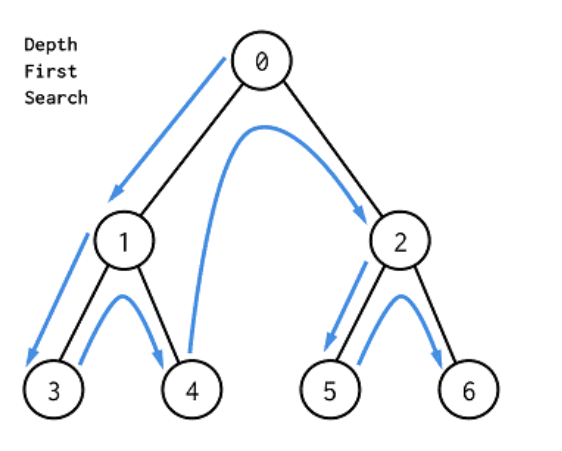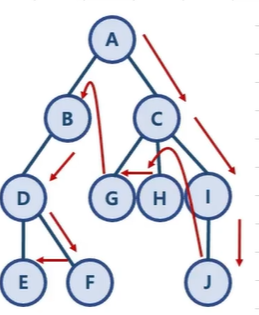DFS

정점의 자식들을 먼저 탐색하는 방식
한 노드의 자식을 타고 끝까지 순회한 후 다시 돌아와서 다른 형제들의 자식을 타고 내려가며 순회한다.
예제

needVisit 스택과, visited 큐를 사용한다.
| visited | A | C | I | | | | |
|---|
| needVisit | B | A | G | H | C | J | |
| visited | A | C | I | J | | |
|---|
| needVisit | B | A | G | H | C | I |
| visited | A | C | I | J | H | |
|---|
| needVisit | B | A | G | C | | |
| visited | A | C | I | J | H | G | | | |
|---|
| needVisit | B | A | C | | | | | | |
| visited | A | C | I | J | H | G | B | D | |
|---|
| needVisit | E | F | | | | | | | |
| visited | A | C | I | J | H | G | B | D | F |
|---|
| needVisit | E | D | | | | | | | |
| visited | A | C | I | J | H | G | B | D | F |
|---|
| needVisit | D | | | | | | | | |
예제 코드
public Queue<String> solution(HashMap<String, List<String>> graph, String startNode) {
Stack<String> needVisit = new Stack<>();
Queue<String> visited = new LinkedList<>();
needVisit.add(startNode);
while (!needVisit.isEmpty()) {
final String node = needVisit.pop();
if (!visited.contains(node)) {
visited.add(node);
needVisit.addAll(graph.get(node));
}
}
return visited;
}
public static void main(String[] args) {
final DfsExam T = new DfsExam();
HashMap<String, List<String>> graph = new HashMap<>();
graph.put("A", new ArrayList<>(Arrays.asList("B", "C")));
graph.put("B", new ArrayList<>(Arrays.asList("A", "D")));
graph.put("C", new ArrayList<>(Arrays.asList("G", "H", "I")));
graph.put("D", new ArrayList<>(Arrays.asList("E", "F")));
graph.put("E", new ArrayList<>(Arrays.asList("D")));
graph.put("F", new ArrayList<>(Arrays.asList("D")));
graph.put("G", new ArrayList<>(Arrays.asList("C")));
graph.put("H", new ArrayList<>(Arrays.asList("C")));
graph.put("I", new ArrayList<>(Arrays.asList("C", "J")));
graph.put("J", new ArrayList<>(Arrays.asList("I")));
System.out.println(T.solution(graph, "A").toString());
}
- 시간복잡도 :
- 노드 수 : V
- 간선 수 : E
= O(V+E)



